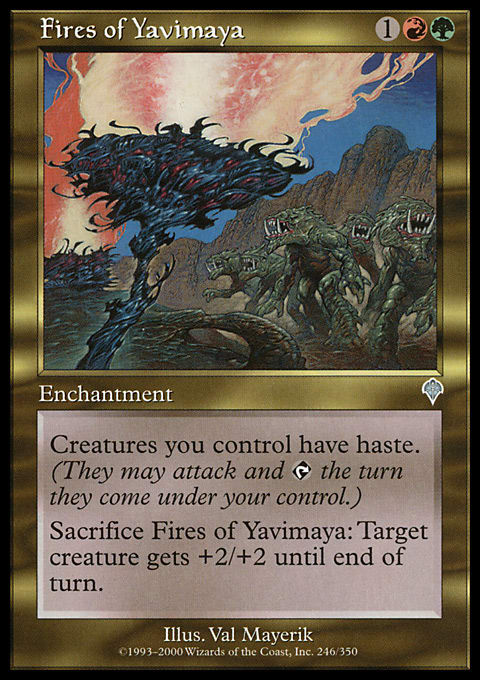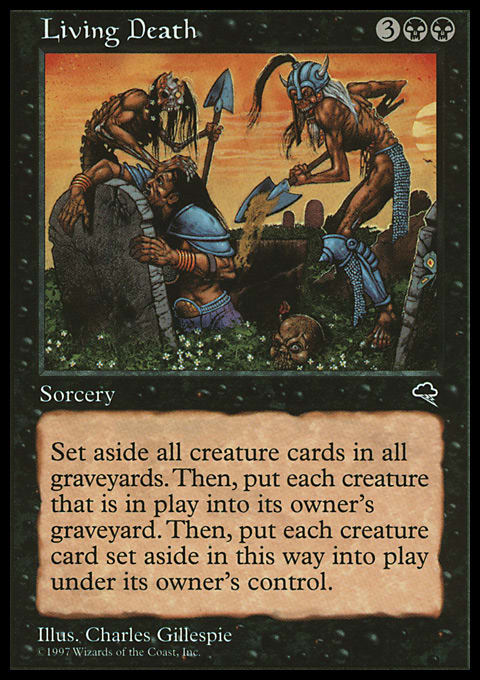The KISS principle can be an excellent default in Magic. While a simplistic one-note deck is rarely the type of deck that wins big events, the formula for success is certainly a far cry from the idea that the more complex a thing is the better. There is a pretty common perception that the harder the deck is to play, the better it is. There is also something of an obsession with having answers for every possible thing an opponent might do. The issue of simplicity versus complexity is an important aspect of both Constructed and Limited.
Like most issues in Magic, the correct answer depends on various conditions: What’s the format like? What’s the environment like? What’s the metagame like? As usual, the better you are at understanding and forecasting these things, the greater your chance for success in a given event. When in doubt, keeping it simple is a useful and frequently successful way to approach Magic.
At Pro Tour: Chicago in 2000, I worked with Team Your Move Games to prepare for the event. Each of the principles—Dave Humpherys, Rob Dougherty, and I—came up with a different approach for the format. Dave went with the most popular approach on the team: building a three-color Fires of Yavimaya deck designed to beat the more basic R/G version of Fires that we expected to be popular at the event. Rob, who had less time to prepare because he had been vacationing with family, decided to keep it simple and play basic R/G Fires. I decided to play an unusual, multicolored Merfolk/Mercenary deck designed to beat Fires of Yavimaya.
While I proved ready for Fires, I lost constantly to the second-most-popular deck: Rebels. Dave’s version proved to be okay against other Fires decks, but it was just weaker against everything else, and none of my teammates did well with that deck. Rob, on the other hand, the one player who kept it simple, powered his way to a Top 8 finish. He was playing the known best deck that he also had a lot of experience playing, and he had the default advantage in every matchup. Rogue decks like mine usually fall quickly out of the winners’ brackets, leaving Rob a clear field of mirror matches, Rebels, and decks that just weren’t as good as his. It left me wishing I had joined Rob on vacation instead of spending so much extra time testing.
Pro Tour: Los Angeles in 1998 is another great example of the KISS principle at work. For many people, the obvious deck to play in Tempest Block was mono-red aggro with Cursed Scrolls and Wastelands. For Team Your Move Games, the card that stood out was Living Death. We were divided how to use the card, however. I played a U/B Living Death deck, and Dave Humpherys and some of my teammates decided to play Dave’s W/U/B version. Dave and I both understood that the deck to beat would be mono-red. We just choose a different approach to beating it. We both played heavy black to support Living Death, and we both included blue for Intuition, but Dave wanted access to a lot of white mana so he could main-deck Staunch Defenders in order to beat red with extra life-gain. He also wanted access to white for Disenchant so he’d have an answer for Humility and Cursed Scroll. If Humility hit the board against my version, it generally meant I was going to lose the game.
The thing that scared me away from Dave’s version was the need for dual lands. The best dual lands in Tempest caused you damage, which seemed bad against red aggro, and these lands made you vulnerable to Wasteland. Yet to support Dave’s deck, it was impossible to avoid using nonbasic lands. I could have used dual lands in my two-color deck, but I decided it was crucial to make my deck invulnerable to Wasteland, so I only used basic Islands and basic Swamps. As a result, I made sure not to need ![]()
![]() for any of my spells and not to need
for any of my spells and not to need ![]()
![]() until I hit 5 mana.
until I hit 5 mana.
I also chose the contents of my deck with red decks and Humility decks in mind:
"Tempest Block Living Death"
- Creatures (16)
- 4 Rats of Rath
- 4 Skyshroud Vampire
- 4 Tradewind Rider
- 4 Bottle Gnomes
- Spells (16)
- 4 Intuition
- 4 Power Sink
- 4 Living Death
- 4 Lobotomy
Humility was still probably my worst matchup, but at least Power Sink and Lobotomy gave me a fighting chance against those decks. In addition, I had Capsize in my sideboard. My matchup against red turned out to be pretty good. Most of my creatures could survive a Cursed Scroll, and if an opponent was on the plan of killing all my creatures, he would just be setting me up for a big Living Death anyway. I could also use Tradewind Riders to make Cursed Scrolls weaker and even return them to be Lobotomied away if needed. I also had Horned Turtles in my sideboard, which were strong against aggro decks. My basic plan against red was to play a Rat or a Power Sink on turn two and Intuition for Bottle Gnomes on turn three. Then, I would play a Gnome on turn four and Living Death on turn five. This would usually buy me more than enough time to take over the game with Riders and Vampires. With twenty-eight lands and all basics, having five lands on turn five was usually a given. This deck is an example of another way that Magic has changed: I can’t cast anything on turn one. In Constructed these days, that’d be pretty insane, but back then, it wasn’t a huge deal.
So, the results of the event strongly suggest that keeping it simple was the way to go. Dave Humpherys finished one hundred sixty-first with the three-color version, and Tom Guevin finished one hundred forty-seven with it. I finished twenty-fifth with my two-color version, and Adam Katz finished fourth with it despite seeing the deck for the first time the night before the event and playing it jaw-droppingly poorly in the Top 8.
The reason: Red decks were everywhere, and my version just matched up better. The mana was more consistent, less painful, and less vulnerable to Wasteland. Further proof of the benefits of keeping it simple was the fact the winner of the event David Price was playing an even simpler deck: Deadguy Red. Dave happened to be the best of a sea of red aggro players at that event. Adam and I were the only two people playing my Living death deck, and the results certainly suggest that simple decks were the way to go.
My Jund Pod deck is another example of being able to make a deck better by making things simpler. My last version tried to do too many things. It was good, but it definitely benefits from some simplification:
"Dark Pod 2.0"
- Creatures (32)
- 1 Bloodflow Connoisseur
- 1 Bloodthrone Vampire
- 1 Rage Thrower
- 2 Huntmaster of the Fells
- 3 Falkenrath Aristocrat
- 4 Birds of Paradise
- 4 Blood Artist
- 4 Borderland Ranger
- 4 Llanowar Elves
- 4 Strangleroot Geist
- 4 Zealous Conscripts
- Spells (4)
- 4 Birthing Pod
- Lands (24)
- 1 Mountain
- 11 Forest
- 3 Swamp
- 1 Kessig Wolf Run
- 4 Copperline Gorge
- 4 Woodland Cemetery
This deck is much more focused and consistent, and it has better mana and more redundancy. I found when I played my first version that the deck had more than enough creatures; I just needed more good sacrifice outlets and more Zealous Conscripts. Falkenrath Aristocrat is a total beating. It can beat Restoration Angel in a fight, it hits for 4 in the air on turn three or four, and it can survive many forms of removal. The deck has plenty of Humans to make it bigger, and it’s a convenient sacrifice outlet for a Rage Thrower or Blood Artist kill. I strongly considered running four of them, but since they use both of my off colors, they’re the hardest spell for me to cast. In addition, since I also have two Huntmaster of the Fells, I’m somewhat busy at 4 mana.
Sure, it’s possible I will occasionally wish I had an Acidic Slime, Thragtusk, or some other creature in the deck to search for, but that’s why the Magic gods invented sideboards. Like my Naya Pod deck, my sideboard will probably consist of fifteen creatures chosen to be able to upgrade the deck in various matchups. I expect to run this version of the deck at some events at Gen Con, so by the time you’re reading this, I’ll have a better idea of what the sideboard should be, and if I see some interesting results, I’ll probably elaborate in a future column.
Many players could benefit from the KISS principle in Limited, too. Too often, players will fall into the trap of playing too many cards that aren’t lands, creatures, or creature removal. Additionally, players will often pass up opportunities to play tight, consistent, and powerful two-color decks in order to add a third color without realistically making their decks better. Whether it’s Limited, Constructed, or even just a play decision, if you’re unsure what direction to go in, I recommend keeping things simple. While of course it’s not always the right choice, it will be often enough to make it worth the gamble when you’re really unsure.





























